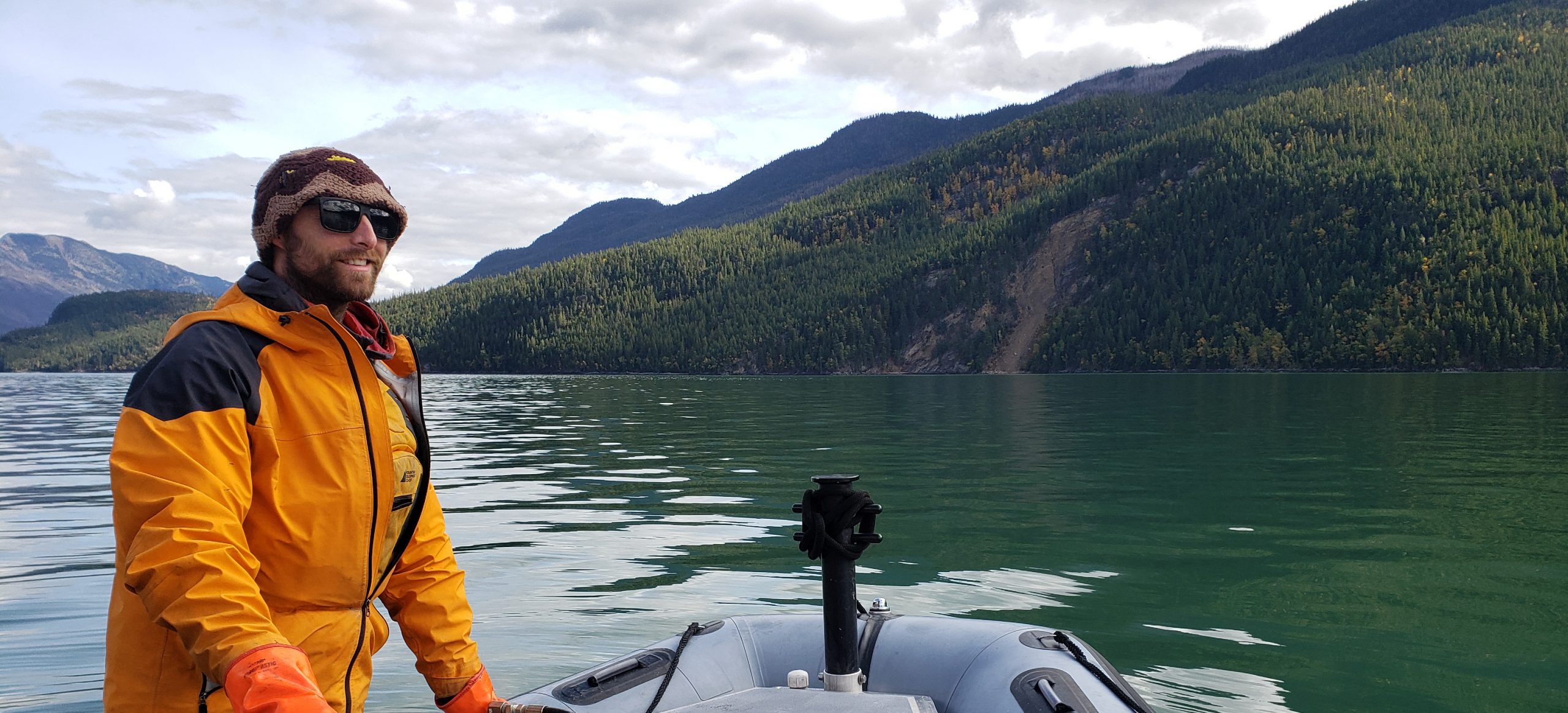1. Can you tell us a little bit about yourself and the program that you are in?
My name is Brody Granger and I completed my M.A.Sc. in Civil Engineering in the discipline of Environmental Fluid Mechanics with Dr. Bernard Laval in 2020. Since then I’ve been working for Dr. Laval as a research assistant, continuing with the project that began in 2014 while working in his lab as an undergraduate research assistant.
2. Can you provide an overview of your research project on Quesnel Lake?
The latest round of research on Quesnel Lake began on the 4th of August, 2014, while I was working for Dr. Bernard Laval as an undergraduate research assistant. I came to work that day to find the news headlines filled with an unfolding environmental disaster near my hometown of Williams Lake, in the interior of BC. A copper and gold mine by the name of Mount Polley was spilling its guts into the surrounding watershed, following the failure of their earth-fill tailings dam, an event which still holds the record for the largest spill of mine waste into a lake. The topic of my M.A.Sc thesis, which I completed in November 2020, was figuring out where the finest sediment from that spill went in the Quesnel Lake and River system. Since then, my focus has shifted from the effects of the spill to ongoing pollution from mine effluent discharge into Quesnel Lake.

3. What were the primary objectives and research questions that guided your study in this specific context?
For my M.A.Sc. thesis I wanted to set the record straight about how much fine sediment remained in suspension in Quesnel Lake during the months and years following the spill, as well as to make some prediction about how long the system would take to substantially flush out this suspended sediment. Rather than relying on a complicated, computationally intensive, numerical model, I found a way to interpret observational data using an analytical model that was as simple as possible, but no simpler.
4. Could you describe the methodology and techniques you employed to assess the ecological and fisheries impacts following the tailings spill?
The first step in my assessment of the spill’s impacts was to relate the observational data which I had available to me – in this case, turbidity, which is a measurement of the cloudiness of the water – to an estimate of concentration (mass of suspended sediment per volume of water). This I did in the lab, measuring the turbidity of varying concentrations of tailings from the spill using the same turbidity sensors as our research group uses in Quesnel Lake. Once I had related turbidity to mass concentration, I compared observational data to the predictions of time-tested analytical models well known to environmental engineers: continuously stirred tank reactors (CSTRs).
5. Were there any unexpected challenges or obstacles you encountered during your research, and how did you address them?
Something that is inherent in the nature of unprecedented disasters is that by the time the research catches up with what is going on, and what data is important to collect, the opportunity to collect that data has already passed. In some cases this can be just plain bad luck, as with my first, post-spill trip to Quesnel Lake, when the instrument we were using to get vital, early-stage data stopped functioning due to an electrical short circuit. Luckily, because of a data sharing agreement between UBC and Mount Polley Mining Corporation that Dr. Laval arranged with representatives of the mine, I was able to use data from a similar instrument which mine personnel had used to measure the physical properties of the lake water following the spill – data which eventually became a small but important part of my analysis.

6. Can you discuss the measures, if any, that were taken to mitigate or remediate the environmental damage in the aftermath of the tailings spill, and their effectiveness?
Within Quesnel Lake itself there have been no measures taken to mitigate or remediate the damage from the tailings spill, for the simple reason that disturbing the tailings deposit at the bottom of the lake would almost certainly do more harm than good. By far the most significant remediation work that Mount Polley Mining Corporation has done in the years since the spill has been in the flooded area around Hazeltine Creek, the channel which conveyed the tailings slurry into Quesnel Lake during the spill. Our research group continues to see elevated copper concentrations during some times of year in water and sediment samples that we collect from Hazeltine Creek, which indicates to us that this channel remains a source of pollution in Quesnel Lake.
7. In what ways do you believe your research can be extended or adapted to other regions facing similar environmental challenges?
Mining is big business all around the world, and anywhere there are mines, there are tailings. While most of the hard lessons learned by the mining industry following the Mount Polley disaster had nothing to do with my research (for example, lessons about proper management and monitoring of earth-fill tailings dams), there are some that my research can inform. For one, in the unfortunate event that another large tailings spill goes into a lake, my research could help to inform what data collection should begin immediately, and how that data might be used to assess the long-term impact of the spill. More broadly, my research can serve as a reminder that simple, analytical models are a valid tool for assessing observational data following such a disaster, and that they should always be consulted first before employing more complicated numerical models.
8. Any future plans after this project?
I plan to move to New Zealand in March to continue pursuing a career in water resources and to play the accordion in a folk band.
